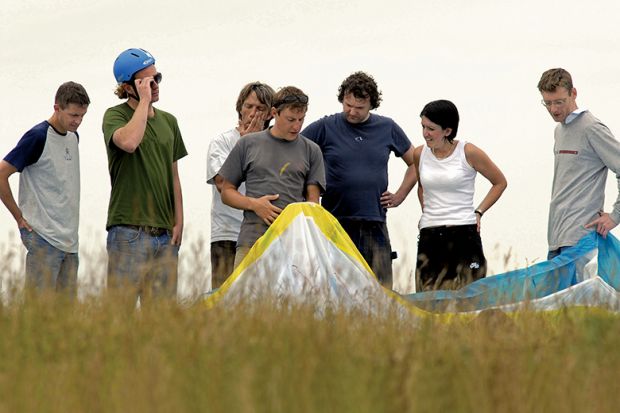The concept of student co-creation – or “students as partners”, to offer universities’ PR-saturated alternative – has gained traction in recent years.
Seen as a way to boost student engagement and improve student-teacher relationships, its methods can include anything from forming working groups to employing students as consultants.
Robin DeRosa, director of the Open Learning & Teaching Collaborative at Plymouth State University in the US, explained that the first step should be understanding why co-created learning is worth exploring.
“It turns students from consumers of knowledge into creators of knowledge and helps involve them in developing goals, designing projects, assessing outcomes and sharing what they have learned…it is not just that students learn, but that they learn how to learn. Involving students as co-creators is one way to focus not just on the content but on the process of learning itself,” she said.
Students could perhaps contribute to a digital textbook for the course − and it’s fine if there are errors in what they produce, as long as you build in an editorial process that encourages feedback and the chance for revision. “Most real scholarship happens in scholarly communities and peer review helps to assure quality,” Dr DeRosa explained.
She added that students have the benefit of a “beginner’s mind”, which allows them to create clear content for other undergraduates because they understand which aspects might be the most complicated for someone who is new to the subject.
Some students might be resistant to the idea, expecting teachers to tell them what to learn, but “once students understand that they can drive their own educations, they not only enjoy the work more but they also feel a sense of relevancy…Like anything, it takes time to develop skills at co-creation, both for faculty and for students, but I think the rewards are significant,” she said.
Jacqueline Labbe, pro vice-chancellor (academic) at De Montfort University in the UK, agreed. The university made student co-creation a central theme in its most recent teaching and learning strategy, and Professor Labbe was determined it would be “more than just warm words”.
One of the ways to do this was by securing investment for undergraduate teaching and learning consultants. There are 10 to 15 appointed every year and they are paid, she said.
“We approach it like we would any consultancy. Students come in with their expertise and provide advice and guidance. They’ve helped us with a lot of work around assessment, feedback and personal tutoring,” she said. “We’ve got a student action committee, [plus] a group of student personal tutoring advocates…I don’t think there is any university activity that doesn’t involve students in some way as equal partners.”
Professor Labbe admitted it can be challenging to reach a broader student body beyond those who are already likely to be engaged. De Montfort is tackling this by demonstrating the impact of the student voice and through a special projects officer on student engagement.
“Show them that the work does have an impact and isn’t just lip service, that it makes a positive change for them,” she said.
And always treat students as equals, Professor Labbe added: “They are the experts in the student experience.”
Eric Tsui, associate director of the Knowledge Management and Innovation Research Centre at the Hong Kong Polytechnic University, has been implementing student co-creation on his courses for the past three years.
“In the ‘real world’, students will need to know how to adapt and apply what they have learned flexibly; they have to continue to learn,” he said.
He is also a professor in the department of industrial and systems engineering, where he decided to get rid of some lectures and instead use that time for co-creation techniques.
“If you are studying process management, I pose the question: ‘How do you think process management will evolve in the next five years?’ It gets them to think about the global trends and the driving forces that are affecting the world,” he said.
It’s important to emphasise to students that they are not being evaluated on whether or not their scenario is right but rather: “Where do you get the data? How do you derive your logic? And how do you argue that these scenarios may be more imminent than others?” he added.
One further benefit for Professor Tsui is that it is an ongoing process that allows him to keep the curriculum up to date − a particularly important factor in a subject that is rapidly changing.
He advised anyone embarking on student co-creation to understand that it’s a learning process and that every institution shouldn’t implement it identically. “You can’t try everything new in one semester; students can’t handle it.”
But Professor Tsui said that students had been extremely receptive to co-creation, and it is now being rolled out in other university departments: “We have excellent feedback. They like being part of brainstorming; they like to be part of the discussions themselves.”
POSTSCRIPT:
Print headline: Make students equal partners
Register to continue
Why register?
- Registration is free and only takes a moment
- Once registered, you can read 3 articles a month
- Sign up for our newsletter
Subscribe
Or subscribe for unlimited access to:
- Unlimited access to news, views, insights & reviews
- Digital editions
- Digital access to THE’s university and college rankings analysis
Already registered or a current subscriber? Login










